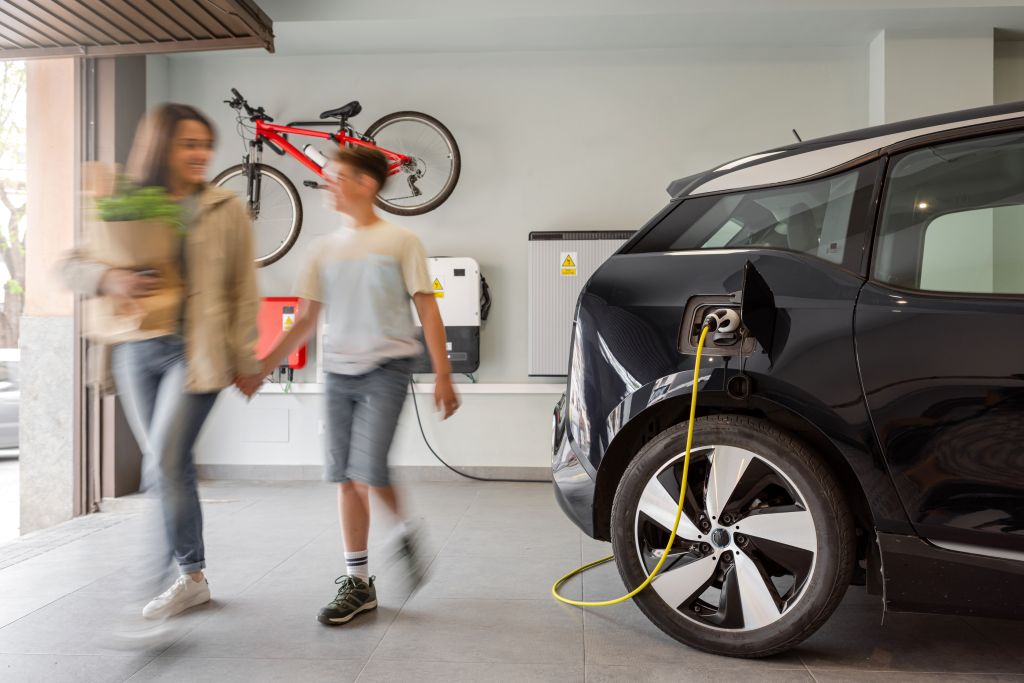Published March 17, 2024 • 10 Min Read
Electric vehicles (EVs) have come a long way since 2011, when they first became available on the Canadian market. When they initially appeared, they were an interesting curiosity, but uptake was not high at the start. Now EVs are an everyday sight across the country with around 200,000 zero-emissions vehicles on the road.
Electric vehicles are a growing market in Canada
And that number is set to increase, thanks to the federal government’s mandate that, by 2026, at least 20 percent of all new cars sold must be zero-emission vehicles, and at least 60 percent by 2030. Fast-forward to 2035, and you’ll be hard-pressed to find many gas-powered vehicles on a dealership lot.
The rapid adoption of EVs isn’t just a result of government policy, though. Drivers are increasingly aware that the transportation sector is one of the largest contributors to national greenhouse gas emissions. And given rising gas prices, EVs may seem like a smarter financial choice. They could be a win-win for you and the Earth.
Read more: The future of electric cars in Canada
If you’re thinking about purchasing an EV, we’ve researched some common questions drivers have about EV ownership. Read on for factors to consider when thinking about an EV purchase.
7 questions to ask before buying an electric car
1. Are electric vehicles better for the environment?
Electric vehicles often come up when the conversation turns to climate change. And that’s logical, because one of the biggest advantages of fully-electric vehicles is that they produce zero tailpipe emissions. Compare that to your typical internal combustion engine vehicle (ICEV), which, according to the Environmental Protection Agency (EPA), emits 4.6 tonnes of carbon dioxide per year.
Indeed, in a thorough analysis of the carbon footprint of an EV compared to that of an ICEV, the Union of Concerned Scientists concluded the EV’s footprint is notably smaller. But there are a couple of lesser-known carbon costs to owning and driving an EV that are worth considering.
An EV’s energy has to come from somewhere, and a portion of most electric grids continue to be powered at least in part by fossil fuels, such as coal and natural gas. That means, in most cases, there will be some related emissions when you charge an EV. Similarly, hybrid vehicles are powered by a combination of gas and electricity, so you can expect some emissions every time you fill up the tank.
Lithium-ion battery production is another consideration. An energy-intensive process, the manufacturing of these batteries typically results in higher emissions than the manufacturing of an entire ICEV.
Nevertheless, EVs remain a less carbon-intensive choice overall. Over time, the carbon emissions that come with manufacturing an EV are offset by their long-term energy efficiency. And that’s good news for buyers. According to the European Environment Agency, the carbon emissions from cars powered by electricity are still up to 30 percent lower than those from gas-powered cars—even once production and electricity generation is factored in.
And, as EVs continue to become increasingly more common on the road, automobile manufacturers are working to establish and implement less carbon-intensive production methods.
2. How do EVs perform compared to gas-powered cars?
If you’re worried about the handling, power and performance of an EV, rest assured that technology has come a long way since EVs became available on the consumer market over a decade ago.Released in 2011, the Nissan LEAF was one of the first models widely available for sale. Today, it continues to be one of the most popular EVs, which is likely why people tend to associate EVs with four-door sedans. But the reality is that there is a wide (and growing) variety of EV models for sale in Canada, ranging from sports cars to family-friendly SUVs.
The only real difference in performance that new EV owners tend to notice? The ride is a lot quieter than it used to be.
3. How far can an EV travel on a typical charge?
The majority of EVs can travel at least 450 kilometres on a single charge, which is more than enough to cover the average Canadian worker’s commute of 57 kilometres one way.
Read more: How to make your EV charge go farther
There’s a catch though, and that’s Canada’s harsh winters. EVs don’t have an engine to produce heat, which means they rely on the battery to do so. According to one study, if you’re running the heater during the winter, expect your range to be reduced by about 40 percent and plan your route accordingly. Extremely hot days, too, can drain the battery’s charge and reduce its overall health; batteries can lose anywhere between four and 17 percent of their capacity, depending on whether air conditioning is used.
Read more: Top tips for driving an EV in Canadian weather
4. How long does it take to charge an EV?
This depends entirely on the battery and the charging point. Plug into a standard 120-volt power outlet (yes, the same kind you plug your toaster into) and you’ll get a full charge—but expect to wait more than 12 hours (and up to 90-plus in some cases). In contrast, a 240-volt, or Level 2, charging unit (like the kind that many owners install in their home garages) takes between six and 12 hours.
In a hurry? A Level 3, or DC Fast, charger—like most of those found at public charging stations—will get you back on the road in less than an hour. There is a caveat, though: according to some EV manufacturers, and to researchers at the University of California, these speedy chargers may reduce your battery’s life slightly over time.
Read more: How to charge your electric car at home
5. Are charging stations easy to find in Canada?
On that note, if you have “range anxiety,” you’re not alone. The fear of running out of battery power is still one of the largest barriers to EV ownership. But it’s a fear you can put to rest, thanks to the country’s rapidly expanding electric car charging station networks, including those operated by Petro-Canada, Tesla and Electrify Canada.
There are around 15,000 public or semi-private Level 3, or DC Fast, chargers available across the country, reaching as far north as Dawson City, Yukon. And there are plans for an additional 65,000 to be built over the next four years.
At present, EV owners travelling along the Trans-Canada Highway or in urban centres will have little difficulty finding a spot to power up. In the Greater Toronto Area, for example, there are already almost 900 charging units, 60 percent of which are free to use.
If you live in a rural or northern area, though, you’ll need to be strategic about your travels to ensure you have access to a charging station when you need one. But, at least these days, more are cropping up all the time, even in some remote locations.
6. Are EVs more expensive than gas vehicles?
Cost is often the main consideration for people wondering if they should buy an electric car.
Even the most affordably priced EVs might run you between $37,000 and $43,000. But there is some good news here: You can offset the cost somewhat through the federal Incentives for Zero-Emissions Vehicles (iZEV) Program. Launched in 2019 and still in operation as of fall 2022, the iZEV Program will put a rebate of up to $5,000 back in your pocket. Depending on where you live, the length of the lease you sign, and the model of car, you may also qualify for provincial rebates of up to $8,000.
It pays to budget for a few other upfront costs, too. If you choose to install a Level 2 charging unit, for example, expect to shell out between $750 and $1,200, plus the price of installation, which is around $1,000. Some provinces, such as BC and New Brunswick, also offer rebate programs for the installation of these chargers.
The RBC Electric Car Cost Calculator can help you to understand the costs of buying and owning an EV.
While the upfront costs of purchasing an EV are significantly higher, it will cost you considerably less to run than an ICEV in the long run. Suppose you drive around 20,000 kilometres annually; it’ll only take about $400 per year to run your EV, versus $1,848 to run an equivalent gas-powered vehicle.
At the moment, the levelized cost of driving (LCOD)—a calculation of how much it costs to drive a vehicle per kilometre over its lifetime—is comparable between EVs and ICEVs. But the Canadian government predicts that, as technology improves and the cost of car and battery production decreases, EVs will gain the competitive advantage in the very near future.
7. Are EVs costly to maintain?
No, and it may cost less than the maintenance on your current gas-powered car. EVs have fewer parts and no oil or transmission fluid to replace. Even their brakes last longer, thanks to regenerative braking (which is when energy from the action of slowing down is sent back into the battery as usable power). So it’s not surprising to learn that the cost of electric vehicle maintenance is about 70 percent lower than that for comparable ICE vehicles, according to a report by the Canada Energy Regulator.
That said, EVs often cost more to repair than their gasoline counterparts. In 2021, predictive analytics firm We Predict analyzed service and repair visits for 19 million vehicles between the 2016 and 2021 model years. It found that the cost difference wasn’t in the parts, but rather in the specialized labour. But this is likely to change as EVs become the industry standard and more mechanics are trained to work on them.
The final maintenance cost to factor in is the battery’s life. Most EV batteries will last for around eight years or 160,000 kilometres. The replacement cost varies based on model and manufacturer. Again, expect to see rapid developments in this department, including in battery reuse and recycling, which will also reduce the lifetime environmental impact of EVs.
So, to summarize, you might consider buying an EV if:
-
Your budget starts at around $38,000. (Remember, though, that as the industry evolves and improves, this number could change and we’ll likely see even lower prices.)
-
You recognize the positive environmental impact of EVs and are committed to reducing your greenhouse gas emissions.
-
You live in an urban or highly populated area with plenty of charging stations.
-
You have the ability and budget to install a Level 2 charging station at your home, which will cost somewhere between $750 to $1,200, plus the price of installation, around $1,000. (If you live in a condo or apartment, you might already have access to a charger in the parking garage.)
-
You trade in your car roughly every seven to eight years or are prepared for the potential costs associated with battery replacement.
-
You plan to use the car for daily commuting or short trips within a range of 200 to 400 kilometres (or have flexibility to wait about an hour for a roadside charge.)
This article is intended as general information only and is not to be relied upon as constituting legal, financial or other professional advice. A professional advisor should be consulted regarding your specific situation. Information presented is believed to be factual and up-to-date but we do not guarantee its accuracy and it should not be regarded as a complete analysis of the subjects discussed. All expressions of opinion reflect the judgment of the authors as of the date of publication and are subject to change. No endorsement of any third parties or their advice, opinions, information, products or services is expressly given or implied by Royal Bank of Canada or any of its affiliates.
Share This Article






